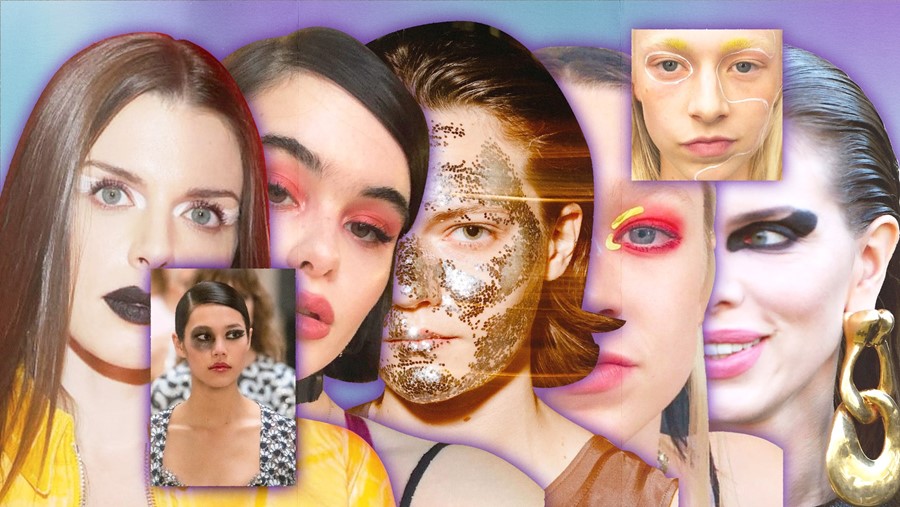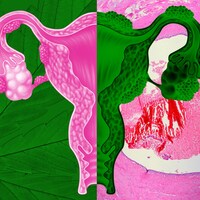Sick of sharp cut creases and precisely placed rhinestones, people are embracing expressive, imperfect make-up
Over the past decade we’ve seen make-up trends pulled in a paradox of two ideals. Most of us have been caught ricocheting between the ‘no make-up make-up’ look romanticised by Glossier, and the IG baddie beat with a full-face base, defined brows and highlighter designed to blind. But now, something new is emerging. As we enter our post-pandemic world, the make-up trends are all about owning that middle ground. This is a make-up movement that rejects perfectionism, and revels in play.
Anti-perfectionist make-up embraces the messiness that comes with creativity. It’s experimentation without worrying about perfection, championing self-expression over prescriptive paint by numbers. We’ve seen it everywhere, from Julia Fox’s abstract smudged liner looks to the runways, where there’s been chaotic face gems at Connor Ives, smokey eyes at Versace, glitter face at Eckhaus Latta and impressionistic eye-makeup at Ulla Johnson. While a soft-focus, Monet-esque eye may sound hard to achieve, the reality is much more like child’s play – smudged and haphazardly applied. Make-up artist Romy Soleimani described the feel as “spontaneous, like finger painting”.
This return to make-up comes following a famine of beauty – as the late, great André Leon Talley would say – over lockdown when cosmetics sales drastically fell. Confined to our homes, we focused on skincare and wellness, our eyeshadow palettes untouched. Now, as the world starts opening back up, it’s more about the experience than the aesthetic. In our haste to leave the house and have fun, hours spent carefully applying countless products feel like a waste of precious, previously lost time. We are picking up our palettes again – cosmetics sales are soaring – but make-up is no longer about concealing, correcting and contouring, it’s focused on freedom, fearlessness and flexibility.
“There is a noticeable change in make-up aesthetics right now,” says make-up artist Victoria Martin. “We’ve been stuck at home for the best part of two years and our new freedom couldn’t feel more exciting, there is change in the air.”
The aesthetic shift can be seen on Euphoria, a show which has always been a North Star for beauty trends, where, for season two, make-up artist Doniella Davy created a softer, more free-form version of its famous glam. Instead of painstakingly applied rhinestones and precise graphic liner, we have swipes of shadow, simpler shapes and softer shades. Think Kat’s single-shadow eyes, Jules’s abstract bowling look, or Cassie's messy NYE glam. It’s still expressive and playful, but much more carefree.
When it comes down to it, anti-perfectionism is a feeling and an atmosphere more than it is a specific look. It is the anti-trend of make-up trends. It can be bold or pared back, intentional or accidental. It’s about abandoning the rules as we know them and using make-up for it’s utopian function – to express creativity, attitude and individuality. “For years, people have been sold an idealised version of beauty,” says Victoria Buchanan, futures director at strategic foresight consultancy The Future Laboratory. “But during lockdowns we saw attitudes to appearance becoming more carefree. Consumers are rejecting toxic perfectionism and eliminating rigid beauty rules with new routines focused on experimental applications.”
While there is huge power in beauty as an artform, much of our attitudes to make-up have become the antithesis of creative freedom. It can often end up as an aesthetic of homogeneity, in which we ‘fix’ our faces to look the same and the small imperfections that make us unique can easily be contoured, corrected or concealed. Beauty, when defined too exclusively, becomes a weapon, and can actually bolster the structures from which we are trying to break free. “People are getting sick of a one-size-fits-all, cookie cutter make-up,” says Martin. “Everyone is starting to look the same. People are sick of the rules and being confined, and they want something fresh, easy and real.”
A much more intuitive approach to beauty, make-up artist Celia Burton says the trend feels like a relief and a return to the freedom she felt as a teenager without social media. There’s an unfiltered, grainy nostalgia to it. “My make-up back then was totally personal and tied to how I was feeling – it combined the anger and angst of being a teenager, but also the experimentation of working out who I was,” she says. And while this isn’t dream matte mousse and concealer lips, it is a return to a more tactile approach to beauty – a finger-smudged shadow over the lids, playing with pigments and the reckless abandon that came with applying make-up without the worry that it needed to be documented, shared and seen by thousands.
Now is the time to redefine our approach to make-up and to reclaim beauty for ourselves. It means reassessing what we find inspiring, and where we find beauty. It’s an exercise in trying to see the world anew, through your own lens; finding the colours, shapes and textures that appeal to you, and complement how you want to present yourself to the world. “Take inspiration from nature or from your favourite artist,” says Martin. “Look at the colours and the shapes, and I mean really look. Use it as inspiration, but don’t feel you need to directly replicate the pattern on a butterfly wing for example, you could take the colour combination and use it for your look. My best advice is to keep it simple, don’t overthink it, life is too short.”
Exhausted by the pressure that comes with digital beauty culture, as we venture back out into the world, we have an opportunity to redefine our new normal, to build our beauty utopia. The future of make-up is as individual as we are. How do you want to see and be seen?




